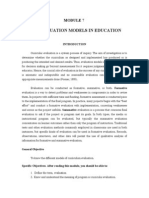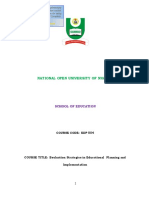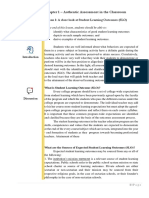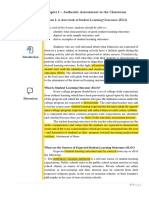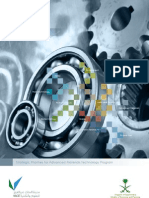0 ratings0% found this document useful (0 votes)
64 viewsCCCCC CC CC CC C C
This document outlines a program specification template for academic programs in Saudi Arabia. It provides guidance on completing sections that describe the program, its context and goals, structure, learning outcomes, admission requirements, and student assessment policies. The template sections include:
- Program identification information
- Program context and relevance
- Mission and goals
- Program structure, requirements, and specializations
- Development of student attributes and skills
- Admission and completion requirements
- Regulations for student assessment
The document instructs users to provide details for each section to comprehensively define the program, its intended learning outcomes, and approach to student learning and evaluation.
Uploaded by
Majmaah_Univ_PublicCopyright
© Attribution Non-Commercial (BY-NC)
Available Formats
Download as DOCX, PDF, TXT or read online on Scribd
0 ratings0% found this document useful (0 votes)
64 viewsCCCCC CC CC CC C C
This document outlines a program specification template for academic programs in Saudi Arabia. It provides guidance on completing sections that describe the program, its context and goals, structure, learning outcomes, admission requirements, and student assessment policies. The template sections include:
- Program identification information
- Program context and relevance
- Mission and goals
- Program structure, requirements, and specializations
- Development of student attributes and skills
- Admission and completion requirements
- Regulations for student assessment
The document instructs users to provide details for each section to comprehensively define the program, its intended learning outcomes, and approach to student learning and evaluation.
Uploaded by
Majmaah_Univ_PublicCopyright
© Attribution Non-Commercial (BY-NC)
Available Formats
Download as DOCX, PDF, TXT or read online on Scribd
You are on page 1/ 14
National Commission for Academic
Accreditation & Assessment
Kingdom of Saudi Arabia
Program Specification
For guidance on the completion of this template, please refer to Chapter 2, section 2.2 of Part 2 of this
Handbook 2 Internal Quality Assurance Arrangement and to the Guidelines on Using the Template for a
Program Specification in Attachment 2 (b).
Institution
College/Department
A. Program Identification and General Information
1 Program title and code
2. Total credit hours needed Ior completion oI the program
3. Award granted on completion oI the program
4. Major tracks/pathways or specializations within the program (eg. transportation or structural
engineering within a civil engineering program or counselling or school psychology within a psychology
program)
5. Intermediate Exit Points and Awards (iI any) (eg. associate degree within a bachelor degree program)
6. ProIessions or occupations Ior which students are prepared. (II there is an early exit point Irom the
program (eg diploma or associate degree) include proIessions or occupations at each exit point)
7. (a) New Program Planned starting date
(b) Continuing Program Year oI most recent major program review
Organization involved in recent major review (eg. internal within the institution,
accreditation review by ? Other?
1
8 Name and position (eg department chair person) oI Iaculty member managing or coordinating the
program.
9. Location iI not on main campus or locations iI program is oIIered in more than one location.
Program Context
1 Explain why the program is needed.
a. Summarize economic reasons, social or cultural reasons, technological developments, national policy
developments or other reasons.
b. Explain the relevance oI the program to the mission oI the institution.
2. Relationship (iI any) to other programs oIIered by the institution/college/department.
a. Does this program oIIer courses that students in other programs are required to take? Yes
No
II yes, what should be done to make sure those courses meet the needs oI students
in the other programs?
b. Does the program require students to take courses taught by other departments? Yes
No
II yes, what should be done to make sure those courses in other departments meet
the needs oI students in this program?
3. Do the students who are likely to be enrolled in the program have any special needs or characteristics
that should be considered in planning the program? (eg. Part time evening students, limited IT or
language skills) Yes No
II yes, what are they?
4. What should be done in the program to respond to these special characteristics?
C. Mission and Goals of the Program
2
1. Program Mission Statement
2. List any major changes or strategic new developments planned Ior the program within the next three to
Iive years to help achieve its mission. For each change or development describe the major strategies to be
Iollowed and list the indicators that will be used to measure achievement.
Major Changes or Developments Strategies Indicators
D. Program Structure and Organization
1 Program Description.
A program or department manual should be available Ior students or other stakeholders and a copy oI the
inIormation relating to this program should be attached to the program speciIication.
This inIormation should include required and elective courses, credit hour requirements and
department/college and institution requirements, and details oI courses to be taken in each year or semester.
2. Development oI Special Student Characteristics or Attributes
List any special student characteristics or attributes beyond normal expectations that the institution, college
or department is trying to develop in all oI its students. ( Normally one or two, up to a maximum oI Iour
that directly reIlect the program mission and distinguish this program Irom others in the same Iield and
make it exceptional. Eg. Graduates particularly good at creative problem solving, leadership capacity,
commitment to public service, high level oI skills in IT). For each special attribute indicate the teaching
strategies and student activities to be used to develop it and the evidence to be used to assess whether it
has been developed in all students.
Special Attributes Strategies or Student Activities to be Used throughout the Program
to Develop These Special Attributes
Strategy
Evidence
Strategy
Evidence
Strategy
3
Evidence
Strategy
Evidence
3. Required Field Experience Component (iI any) (Eg. internship, cooperative program, work experience)
Summary oI practical, clinical or internship component required in the program.
Note that a more detailed Field Experience SpeciIication comparable to a course speciIication should also
be prepared in a separate document Ior any Iield experience required as part oI the program.
a. BrieI description oI Iield experience activity
b. List the major intended learning outcomes Ior the program to be developed through the Iield experience
c. At what stage or stages in the program does the Iield experience occur? (eg. year, semester)
d. Time allocation and scheduling arrangement. (Eg. 3 days per week Ior 4 weeks, Iull time Ior one
semester)
e. Number oI credit hours
4. Project or Research Requirements (iI any)
Summary oI any project or thesis requirement in the program. (Other than projects or assignments within
individual courses) (A copy oI the requirements Ior the project should be attached.)
a. BrieI description
b. List the major intended learning outcomes oI the project or research task.
c. At what stage or stages in the program is the project or research undertaken? (eg. year, semester)
4
d. Number oI credit hours
e. Summary description oI provisions Ior student academic advising and support.
I. Description oI assessment procedures (including mechanism Ior veriIication oI standards)
5. Development oI Learning Outcomes in Domains oI Learning
For each oI the domains oI learning shown below indicate:
O The knowledge or skill the program is intended to develop and the level oI that knowledge and
skill. (as a guide see general descriptions oI knowledge and skills in the National QualiIications
Framework Ior the qualiIication level oI this program;
O The teaching strategies to be used in courses in the program to develop that knowledge and those
skills. (This should be a general description oI the approaches taken throughout the program but
iI particular responsibility is to be assigned to certain courses this should be indicated.);
O The methods oI student assessment to be used in courses n the program to evaluate learning
outcomes in the domain concerned.
a. Knowledge
(i) Summary description oI the knowledge to be acquired
(ii) Teaching strategies to be used to develop that knowledge
(iii) Methods oI assessment oI knowledge acquired
5
b. Cognitive Skills
(i) Cognitive skills to be developed and level oI perIormance expected
(ii) Teaching strategies to be used to develop these cognitive skills
(iii) Methods oI assessment oI students cognitive skills
c. Interpersonal Skills and Responsibility
(i) Description oI the level oI interpersonal skills and capacity to carry responsibility to be developed
(ii) Teaching strategies to be used to develop these skills and abilities
6
(iii)Methods oI assessment oI students interpersonal skills and capacity to carry responsibility
d. Communication, InIormation Technology and Numerical Skills
(i) Description oI the communication, IT and numerical skills to be developed
(ii) Teaching strategies to be used to develop these skills
(iii) Methods oI assessment oI students numerical and communication skills
7
e. Psychomotor Skills (iI applicable)
(i) Description oI the psychomotor skills to be developed and the level oI perIormance required
(ii) Teaching strategies to be used to develop these skills
(iii) Methods oI assessment oI students psychomotor skills
6. Admission Requirements Ior the program
Attach handbook or bulletin description oI admission requirements including any course or experience
prerequisites.
7. Attendance and Completion Requirements
Attach handbook or bulletin description oI requirements Ior:
a. Attendance.
b. Progression Irom year to year.
c. Program completion
E. Regulations for Student Assessment and Verification of Standards
1. Regulations or policies Ior allocation and distribution oI grades
II the institution, college, department or program has policies or regulations dealing with the allocation or
distribution oI students grades state the policy or regulation, or attach a copy.
8
2. What processes will be used Ior veriIying standards oI achievement (eg check marking oI sample oI tests
or assignments? Independent assessment by Iaculty Irom another institution) (Processes may vary Ior
diIIerent courses or domains oI learning. )
Student Administration and Support
1. Student Academic Counselling
Describe arrangements to be made Ior academic counselling and advice Ior students, including both
scheduling oI Iaculty oIIice hours and advice on program planning, subject selection and career planning
(which might be available at college level)
2. Student Appeals
Attach regulations Ior student appeals on academic matters, including processes Ior consideration oI those
appeals.
G. Text and Reference Material
1. What process is to be Iollowed by Iaculty in the program Ior planning and acquisition oI text, reIerence
and other resource material including electronic and web based resources?
2. What processes are to be Iollowed by Iaculty in the program Ior evaluating the adequacy oI book,
reIerence and other resource provision?
9
. aculty and other Teaching Staff
1. Appointments
Summarize the process oI employment oI new teaching staII to ensure that they are appropriately qualiIied
and experienced Ior their teaching responsibilities.
2. Participation in Program Planning, Monitoring and Review
Explain the process Ior consultation with and involvement oI teaching staII in monitoring program quality,
annual review and planning Ior improvement.
3. ProIessional; Development
What arrangements are made Ior proIessional development oI teaching staII Ior:
(a) Improvement oI skills in teaching?
(b) Other proIessional development including knowledge oI research and developments in their Iield oI
teaching?
4. Preparation oI New Teaching StaII
Describe the process used Ior orientation and/or induction oI new, visiting or part time teaching staII to
ensure Iull understanding oI the program and the role oI the course(s) they teach as components within it.
10
5. Part Time and Visiting Teaching StaII
Provide a summary oI Program/Department/ College/institution policy on appointment oI part time and
visiting teaching staII. (ie. Approvals required, selection process, proportion oI total teaching staII etc.)
I. Program Evaluation and Improvement Processes
1. EIIectiveness oI Teaching
a. What processes will be used to evaluate and improve the strategies planned Ior developing learning in
the diIIerent domains oI learning? (eg. assessment oI learning achieved, advice on consistency with
learning theory Ior diIIerent types oI learning, assessment oI understanding and skill oI teaching staII in
using diIIerent strategies)
b. What processes will be used Ior evaluating the skills oI teaching staII in using the planned strategies?
2. Overall Program Evaluation
a. What strategies will be used in the program Ior obtaining assessments oI the overall quality oI the
program and achievement oI its intended learning outcomes:
(i) Irom current students and graduates oI the program?
11
(ii) Irom independent advisors and/or evaluator(s)?.
(iii) Irom employers and/or other stakeholders.
b. What key perIormance indicators will be used to monitor and report annually on the quality oI the
program?
c. What processes will be Iollowed Ior reviewing these assessments and planning action to improve the
program?
Attachments.
1. Copies oI regulations and other documents reIerred to in template preceded by a table oI contents.
2. Course speciIications Ior all courses including Iield experience speciIication iI applicable.
12
Allocation of Responsibilities for Learning Outcomes to Courses
Learning Outcomes Courses
Course Code and
Number
Knowledge
Facts
Concepts, theories
Procedures
Cognitive Skills
Apply skills when asked
Creative thinking and
problem solving
Interpersonal Skills
and Responsibility
Responsibility Ior own
learning
Group participation and
leadership
Act responsibly-personal
and proIessional situations
Ethical standards oI
behavior
Communication IT
and Numerical Skills
Oral and written
communication
Use oI IT
Basic maths and statistics
Psychomotor Skills
\ Major Responsibility x Minor Responsibility
(Note: Add additional sheets iI necessary to provide Ior all required courses in the program including any courses oIIered by other departments)
13
You might also like
- 9 Stage Planner On Where We Are in Place and Time80% (5)9 Stage Planner On Where We Are in Place and Time4 pages
- COPPA 2 New Guidelines On Standards and Criteria FR Accreditation of Dental Degree Programmes 2019No ratings yetCOPPA 2 New Guidelines On Standards and Criteria FR Accreditation of Dental Degree Programmes 201919 pages
- How To Prepare Self-Assessment Report (SAR)No ratings yetHow To Prepare Self-Assessment Report (SAR)65 pages
- Criteria For Accrediting Computing Programs: Effective For Evaluations During The 2010-2011 Accreditation CycleNo ratings yetCriteria For Accrediting Computing Programs: Effective For Evaluations During The 2010-2011 Accreditation Cycle6 pages
- Kingdom of Saudi Arabia: Revised March 2007No ratings yetKingdom of Saudi Arabia: Revised March 20078 pages
- Curriculum Review Action Plans and Reports Sept 2019No ratings yetCurriculum Review Action Plans and Reports Sept 201915 pages
- Attachment I - Interrogatories Alternative Learning Opportunities Programs For High School StudentsNo ratings yetAttachment I - Interrogatories Alternative Learning Opportunities Programs For High School Students7 pages
- Guidelines For Presentation of Learning Programmes-1No ratings yetGuidelines For Presentation of Learning Programmes-117 pages
- CS127-Problem Solving and Programming 2-Syllabus 2012-ITNo ratings yetCS127-Problem Solving and Programming 2-Syllabus 2012-IT5 pages
- M.SC Twoyear Syllabus (31.07.2023) 23-24No ratings yetM.SC Twoyear Syllabus (31.07.2023) 23-2486 pages
- School Based PD Program Design Quality Standards Checklist100% (1)School Based PD Program Design Quality Standards Checklist7 pages
- Enclosure No. 8 PD Progrm Design QS ChecklistNo ratings yetEnclosure No. 8 PD Progrm Design QS Checklist6 pages
- Educational Psychology and Educational Technology PHD Program HandbookNo ratings yetEducational Psychology and Educational Technology PHD Program Handbook38 pages
- Distance Education Format Proposal For A Proposed or Registered ProgramNo ratings yetDistance Education Format Proposal For A Proposed or Registered Program5 pages
- Curriculum and Program Development Template finalNo ratings yetCurriculum and Program Development Template final4 pages
- Academic Program Assessment Handbook: Guidelines DocumentNo ratings yetAcademic Program Assessment Handbook: Guidelines Document50 pages
- A Learning Module in Assessment in Student Learning Ii: Prepared By: Ms. Eden V. CalimagNo ratings yetA Learning Module in Assessment in Student Learning Ii: Prepared By: Ms. Eden V. Calimag6 pages
- Guidance On Formulating Programme Aims and Learning Outcomes General GuidanceNo ratings yetGuidance On Formulating Programme Aims and Learning Outcomes General Guidance3 pages
- Title Iii, Part A Strengthening Institutions ProgramNo ratings yetTitle Iii, Part A Strengthening Institutions Program38 pages
- Preparing The Engineering Technology Self-Study: Steve WendelNo ratings yetPreparing The Engineering Technology Self-Study: Steve Wendel46 pages
- Self Assessment Report Writing: Muhammad Ismail Director Quality Assurance, NUSTNo ratings yetSelf Assessment Report Writing: Muhammad Ismail Director Quality Assurance, NUST84 pages
- Civil Engineering Program Spec 13-12-2018 6ربيع الثاني1440 1057 ص Program Spec. - Final Dr. Mahmoud S. El-KadyNo ratings yetCivil Engineering Program Spec 13-12-2018 6ربيع الثاني1440 1057 ص Program Spec. - Final Dr. Mahmoud S. El-Kady23 pages
- Achieving your Award in Education and Training: The Comprehensive Course Companion (Special Edition)From EverandAchieving your Award in Education and Training: The Comprehensive Course Companion (Special Edition)No ratings yet
- Mechanical and Industrial Engineering CurriculumNo ratings yetMechanical and Industrial Engineering Curriculum4 pages
- Handbook For Quality Assurance and Accreditation in Saudi Arabia - 3No ratings yetHandbook For Quality Assurance and Accreditation in Saudi Arabia - 375 pages
- Application Form For Promotion of Faculty MembersNo ratings yetApplication Form For Promotion of Faculty Members9 pages
- Industrial and Systems Engineering CurriculumNo ratings yetIndustrial and Systems Engineering Curriculum4 pages
- Set Theory: DR Muhammad Al - Salamah, College of Engineering, Majmaah University 26 - Nov - 11No ratings yetSet Theory: DR Muhammad Al - Salamah, College of Engineering, Majmaah University 26 - Nov - 1117 pages
- Strategic Technologies: Advanced MaterialsNo ratings yetStrategic Technologies: Advanced Materials188 pages
- Activity No. 10 The Art of Preparing Examinations/Test QuestionsNo ratings yetActivity No. 10 The Art of Preparing Examinations/Test Questions27 pages
- Process-Oriented Performance-Based Assessment Part 1100% (1)Process-Oriented Performance-Based Assessment Part 144 pages
- AQAS Criteria & Indicators Programme Accreditation 2019No ratings yetAQAS Criteria & Indicators Programme Accreditation 20196 pages
- Why Do We Assess?: Consider The Reasons For Assessment in This Presentation. Do They Reflect Your Own Reasons?No ratings yetWhy Do We Assess?: Consider The Reasons For Assessment in This Presentation. Do They Reflect Your Own Reasons?11 pages
- General Methods of Teaching (EDU 301) : Lecture # 01 Lecture ObjectivesNo ratings yetGeneral Methods of Teaching (EDU 301) : Lecture # 01 Lecture Objectives53 pages
- Successfully Teaching Ethics For Effective Learning: Ronald - Sims@business - Wm.edu Ed - Felton@business - Wm.eduNo ratings yetSuccessfully Teaching Ethics For Effective Learning: Ronald - Sims@business - Wm.edu Ed - Felton@business - Wm.edu19 pages
- CH 1 Materials Evaluation - Tomlinson, 2003No ratings yetCH 1 Materials Evaluation - Tomlinson, 200322 pages
- Developing Pancasila and Citizenship Education Lesson Plan Based On 2013 Curriculum in Senior High SchoolNo ratings yetDeveloping Pancasila and Citizenship Education Lesson Plan Based On 2013 Curriculum in Senior High School10 pages
- Coping Mechanisms On Challenges Met by Teachers in Modular Distance LearningNo ratings yetCoping Mechanisms On Challenges Met by Teachers in Modular Distance Learning69 pages
- TOWES (Test of Workplace Essential Skills)No ratings yetTOWES (Test of Workplace Essential Skills)6 pages
- COPPA 2 New Guidelines On Standards and Criteria FR Accreditation of Dental Degree Programmes 2019COPPA 2 New Guidelines On Standards and Criteria FR Accreditation of Dental Degree Programmes 2019
- Criteria For Accrediting Computing Programs: Effective For Evaluations During The 2010-2011 Accreditation CycleCriteria For Accrediting Computing Programs: Effective For Evaluations During The 2010-2011 Accreditation Cycle
- Curriculum Review Action Plans and Reports Sept 2019Curriculum Review Action Plans and Reports Sept 2019
- Attachment I - Interrogatories Alternative Learning Opportunities Programs For High School StudentsAttachment I - Interrogatories Alternative Learning Opportunities Programs For High School Students
- Guidelines For Presentation of Learning Programmes-1Guidelines For Presentation of Learning Programmes-1
- CS127-Problem Solving and Programming 2-Syllabus 2012-ITCS127-Problem Solving and Programming 2-Syllabus 2012-IT
- School Based PD Program Design Quality Standards ChecklistSchool Based PD Program Design Quality Standards Checklist
- Educational Psychology and Educational Technology PHD Program HandbookEducational Psychology and Educational Technology PHD Program Handbook
- Distance Education Format Proposal For A Proposed or Registered ProgramDistance Education Format Proposal For A Proposed or Registered Program
- Academic Program Assessment Handbook: Guidelines DocumentAcademic Program Assessment Handbook: Guidelines Document
- A Learning Module in Assessment in Student Learning Ii: Prepared By: Ms. Eden V. CalimagA Learning Module in Assessment in Student Learning Ii: Prepared By: Ms. Eden V. Calimag
- Guidance On Formulating Programme Aims and Learning Outcomes General GuidanceGuidance On Formulating Programme Aims and Learning Outcomes General Guidance
- Title Iii, Part A Strengthening Institutions ProgramTitle Iii, Part A Strengthening Institutions Program
- Preparing The Engineering Technology Self-Study: Steve WendelPreparing The Engineering Technology Self-Study: Steve Wendel
- Self Assessment Report Writing: Muhammad Ismail Director Quality Assurance, NUSTSelf Assessment Report Writing: Muhammad Ismail Director Quality Assurance, NUST
- Civil Engineering Program Spec 13-12-2018 6ربيع الثاني1440 1057 ص Program Spec. - Final Dr. Mahmoud S. El-KadyCivil Engineering Program Spec 13-12-2018 6ربيع الثاني1440 1057 ص Program Spec. - Final Dr. Mahmoud S. El-Kady
- PMI-PgMP Exam Navigator: Expert Q&A with Detailed ExplanationsFrom EverandPMI-PgMP Exam Navigator: Expert Q&A with Detailed Explanations
- Achieving your Award in Education and Training: The Comprehensive Course Companion (Special Edition)From EverandAchieving your Award in Education and Training: The Comprehensive Course Companion (Special Edition)
- Handbook For Quality Assurance and Accreditation in Saudi Arabia - 3Handbook For Quality Assurance and Accreditation in Saudi Arabia - 3
- Set Theory: DR Muhammad Al - Salamah, College of Engineering, Majmaah University 26 - Nov - 11Set Theory: DR Muhammad Al - Salamah, College of Engineering, Majmaah University 26 - Nov - 11
- Activity No. 10 The Art of Preparing Examinations/Test QuestionsActivity No. 10 The Art of Preparing Examinations/Test Questions
- Process-Oriented Performance-Based Assessment Part 1Process-Oriented Performance-Based Assessment Part 1
- AQAS Criteria & Indicators Programme Accreditation 2019AQAS Criteria & Indicators Programme Accreditation 2019
- Why Do We Assess?: Consider The Reasons For Assessment in This Presentation. Do They Reflect Your Own Reasons?Why Do We Assess?: Consider The Reasons For Assessment in This Presentation. Do They Reflect Your Own Reasons?
- General Methods of Teaching (EDU 301) : Lecture # 01 Lecture ObjectivesGeneral Methods of Teaching (EDU 301) : Lecture # 01 Lecture Objectives
- Successfully Teaching Ethics For Effective Learning: Ronald - Sims@business - Wm.edu Ed - Felton@business - Wm.eduSuccessfully Teaching Ethics For Effective Learning: Ronald - Sims@business - Wm.edu Ed - Felton@business - Wm.edu
- Developing Pancasila and Citizenship Education Lesson Plan Based On 2013 Curriculum in Senior High SchoolDeveloping Pancasila and Citizenship Education Lesson Plan Based On 2013 Curriculum in Senior High School
- Coping Mechanisms On Challenges Met by Teachers in Modular Distance LearningCoping Mechanisms On Challenges Met by Teachers in Modular Distance Learning





